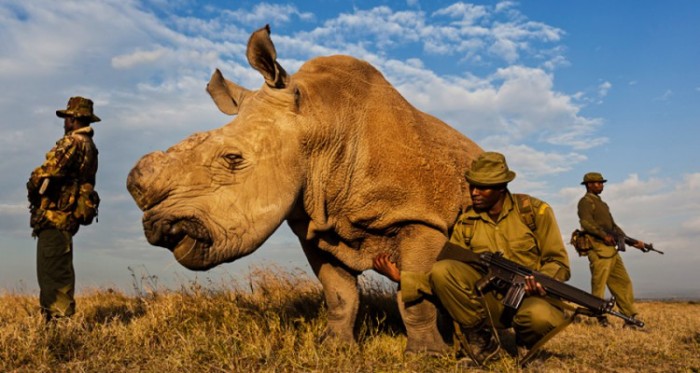
There is a difference between extinction that occurs as a result of gradual changes in the biosphere and extinction that occurs as a result of human activity. The former is a slow process, one that takes generations. Since it is such a slow process, other species have time to adapt, to find other sources of food. The latter is quick, and may take just a decade (or less). Because it happens so rapidly, it often significantly disrupts (and even destroys) local habitats.
Enter the Northern White Rhino.
We have witnessed species after species fall to extinction. In 2013, the latest review of animals and plants by the International Union for Conservation of Nature found that the Western Black rhino had been totally wiped out. But we saw that coming. Things weren’t looking too good for these rhino for quite some time. By 1980, the population was estimated in the hundreds. By 2000, only 10 survived. And in 2006, a survey of the last remaining habitat failed to find any Western black rhinos.
Now, it seems that the Northern white rhino is about to fall over the brink.
Though they used to roam in numbers across Africa, the rhino population declined dramatically due to human encroachment and poaching. In the 1960s, there were more than 2,000 northern white rhinos (these numbers were not promising, but they were something). However, by 1984 only about 15 individuals survived in the wild. Unfortunately, the decrease in the population has not altered the attitudes of many who wish to use the rhino horns for herbal medicine and other crafts.
In 2013, on the streets, rhino horn went for about $65,000 per kg.

And this week, zookeepers announced that there are only 4 northern white rhino left in all the world. This news comes as a result of the death of Nabiré, a 31-year-old female rhino who was living in the Dvůr Králové Zoo in the Czech Republic. The zookeepers assert that she passed on Monday due to a ruptured cyst, which was too large to treat.
Přemysl Rabas, the director of the zoo, said in a statement, “It is a terrible loss. Nabiré was the kindest rhino ever bred in our zoo. It is not just that we were very fond of her. Her death is a symbol of the catastrophic decline of rhinos due to a senseless human greed. Her species is on the very brink of extinction.” In the response to the continued decline of the white rhino, Ol Pejeta Conservancy, had this to say. “The species now stands at the brink of complete extinction, a sorry testament to the greed of the human race.”
However, there is some hope, as conservationists are hoping that they can make a viable embryo by harvesting eggs from Nabiré’s, ovary. Yet, the chances of success are slim.
The Human Problem.
Though extinction is natural, this process is currently fueled by human actions. In the Americas, 80% of large animals became extinct around the same time as first Western humans arrived. Of course, many species went extinct before humans arrived, but (as the previous statistic indicates) we have caused the numbers to skyrocket due to deforestation, habitat destruction, and overhunting (among other things). Where rhinos are concerned, we are not talking about a naturally occurring process. This is notable, as ecosystems evolve slowly over time, forming a community that is linked by a number of tendrils. The biosphere is complex, and if any of these tendrils snap, it could have a plethora of unforeseen (and rather negative) consequences.
A general ecological rule is: That which tends to increase diversity is good; that which tends to decrease it is bad.
Thus, the current human fueled mass extinction event is quite bad (hello, understatement of the year) and not at all beneficial to the biosphere as a whole.
READ NEXT: 65% of Forest Elephants Lost Between 2002 and 2013
Portions of this article were borrowed from a previous article on the same topic.